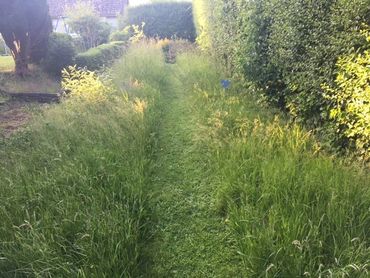A Rewilded Garden
If you want a healthy garden full of colour and life, rewilding is for you. It takes less effort than conventional gardening, and all of the plants are already in place, waiting for a chance to grow - no wildflower mixes needed. Rewilding part of your garden is also one very easy step to help restore UK biodiversity with habitats including long grass, hedges and ponds.

Let your grass grow
If you are ready to try rewilding, letting part of your lawn grow is the easiest way to get started:
- Choose a bit of your lawn (a quiet section might work best)
- Stop mowing it and see what grows
When you do this, the native plants in your lawn will start to flourish, providing food and shelter for a wide range of invertebrates, birds, mammals and amphibians. You can do one mow in September once all the plants have seeded, but a completely undisturbed section will lead to a more developed habitat.
Make some space for nature
If you want more birds and butterflies in your garden, you have to leave enough space for caterpillars to feed, for insects to hibernate and for native plants and fungi to grow. The more you allow the hidden side of nature to develop, the more benefits you will see. Don’t overtidy - leaf litter under hedges, log piles and garden ‘waste’ stacked into a quiet corner all make perfect habitats for insects, beetles and small mammals including hedgehogs.
No poisons
As your garden grows, creatures who feed on your garden pests will naturally move in. But if you use any form of insecticide, fungicide, herbicide or pesticide, it will ruin your rewilding efforts. When you poison slugs and snails you take away a food source from frogs, toads and birds - and likely poison the frogs, toads and birds as well. Sprayed ‘weeds’ will kill your pollinators, and destroy an excellent food source for birds.
Use a blue heart to make a statement
If you are worried how your neighbours will view your rewilding efforts, put out a blue heart to start a conversation and show it is an intentional act. If you decide to make your own, the local recycling centre can be a good source of wood. We use cornflower blue on our official hearts, but any shade will do!
Blue Campaign Blog

This website uses cookies.
We use cookies to analyze website traffic and optimize your website experience. By accepting our use of cookies, your data will be aggregated with all other user data. Privacy Policy